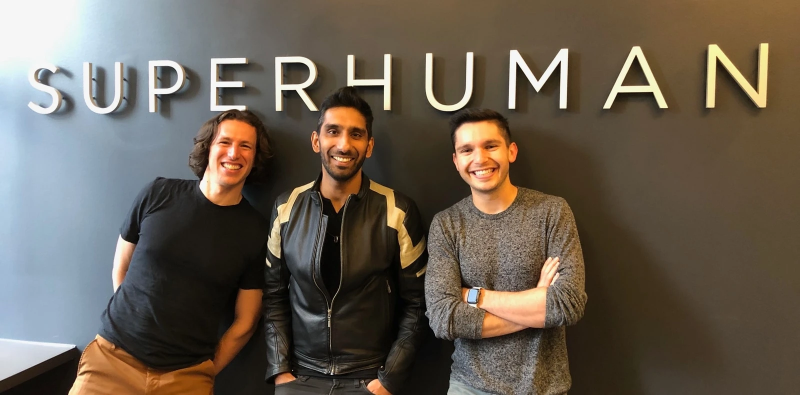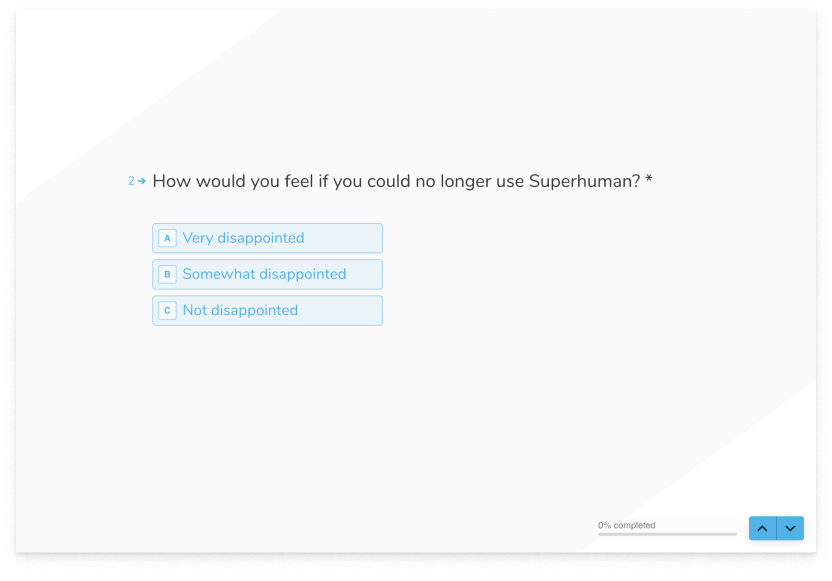Opinions and Expertise
Building a Superhuman growth funnel to find product-market fit
How do you make space in a crowded market? See how the world's fastest email experience does it by automatically pre-qualifying prospects to focus on delivering a perfect experience.

A recent McKinsey study found that professionals spend an average of 28% of their working day in emails. Good thing Google’s perfected that experience, right?
Gaurav Vohra doesn' t think so. As the Head of Growth at Superhuman—a startup building the fastest email experience in the world—Gaurav and the team thinks that email’s still in its infancy. And for $30 a month, Superhuman will build you a grownup version.
How do they plan to build a better email experience than Google, and get people to pay for it?
They start with the same principle used by Gmail' s founder Paul Buchheit. The 100 millisecond rule: every interaction should be faster than 100ms. Why? Because 100ms is the threshold where interactions feel instantaneous. The team at Superhuman obsesses about speed and uses this rule to inform every single product decision.
The need for speed also guides how they target customers. Rather than trying to please everyone, they focus only on those people they know they can serve: people who need Superhuman speed.
It’s the ultimate exercise in finding product-market fit. And Superhuman knows exactly how to do it.
Building a Superhuman growth funnel
Rahul Vohra, founder and CEO of Superhuman, is no stranger to the startup game. His first company—Rapportive—launched, scaled and was acquired by LinkedIn in less than two years. But now he’s more than two years into his next challenge: building an email service that he knows can be the next big thing.
Like many hyper-growth startups, their challenge is two-fold: find just the right customers and build precisely for them. That means they have to prioritize which customers they can best serve now, while growing a list of future customers that they can serve once they complete development of existing priorities.
To do this, Superhuman created two main customer touchpoints that are nearly entirely automated to have meaningful conversations at scale.
- An onboarding survey to qualify potential future customers
- A customer feedback survey aimed at optimizing and informing their product development roadmap
These surveys enable Superhuman to converse with hundreds of thousands of prospects with a small team of just two people.
It’s part of their Superhuman growth funnel, powered by a suite of interconnected tools like Zapier, Airtable, and Calendly. And it all starts with a typeform.
Identifying best customers with automated lead qualification
When Superhuman launched their early access program, they realized the number of emails they handled manually was way too vast. They also wanted a more structured way of asking questions. That’s when they turned to Typeform.
Their onboarding survey is a full page typeform embedded on Superhuman’s welcome page.
It asks visitors roughly twenty questions, all designed to help the Superhuman team assess how well they can serve a potential customer. Things like what devices, browsers, extensions, and integrations they use with their current email client.
To focus only on relevant issues and avoid redundant questions, their survey uses logical follow-up questions based on responses. So for example, if a prospect doesn’t use a MacBook, the survey will skip questions related to MacBooks and jump straight to the next section.
By asking careful qualifying questions, Superhuman builds a prospect profile. All this input goes into their qualification algorithm which triages prospects into two buckets:
- Good customers - Superhuman is the perfect fit
- Potential customers - maybe, but not right now
If Superhuman is a perfect fit for a visitor, they’re taken to a thank you page with the message: “Congratulations! You' ve made it to the top of the list.” A button links them to another page where they can gain direct access to the product and book their Superhuman onboarding appointment via Calendly.
If the answers instead indicate Superhuman is not a great fit for the visitor, they receive a polite message explaining why and potential next steps. For example, if an Android user says that mobile email experience is essential, they get a message that Superhuman is currently only available on iOS, but they’ll let them know when their upcoming Android app is available.
This process helps the team set the right expectations, rather than wasting a prospect' s time, whose needs they can’t meet. The typeform also helps inform the team of which features the prospect needs, so that they can fully customize and perfect the onboarding experience. Finally, the typeform helps them to identify feature gaps that may be slowing growth.
The automated process lets the Superhuman team send relevant messages to interested prospects without lifting a finger.
Automation magic: fifteen employees with no extra cost
When the typeform is submitted, a webhook shoots the data over to Superhuman’s database. This info is simultaneously picked up by Zapier, which automatically organizes the prospects into one of the two qualification buckets.
The data then flows directly into a database, where their onboarding team has access to everything they need to delightfully onboard their customers.
Based on past experience with a similar process, the Superhuman team estimates it would’ve required seventeen people: two to clean up the data, three for backend processes, and another thirteen to collect and dissect responses and manage customer communications.
When they added Typeform and Zapier into the mix, their team of two was more than enough.
It also frees up time for the most important interactions.
Some flows need (Super)human-to-human interaction
The onboarding typeform makes sure the Superhuman team has the right information on their highly qualified customers. A Calendly integration sets up a time to get new customers up and running with their lightning fast email experience.
But when it comes to the Superhuman onboarding, there’s no replacing real humans. As Gaurav puts it:
These human interactions ensure that the customer gets to value faster. After all, speed is what Superhuman is all about. Rahul and Gaurav also say these onboarding conversations alone have provided years worth of insights into future technology they could build.
And in the meantime, there’s another typeform that keeps the conversation going.
Enter the Superhuman feedback loop
Getting customers up and running is just the beginning. To make sure they continue to provide the best service for their best customers, Superhuman keeps a tight feedback loop.
To do this, Superhuman sends an email to their customers asking them four questions:
- How would you feel if you could no longer use Superhuman?
- What type of people do you think would most benefit from Superhuman?
- What is the main benefit you receive from Superhuman?
- How can we improve Superhuman for you?
This data is dropped directly into an Airtable where their product team can aggregate and analyze the data to assess product-market fit.
The team at Superhuman uses all this information to better understand their customers and how to prioritize the features they ship to the market. Fifty percent of their priority is devoted to further their mission to build the fastest email client in the world, and the remaining fifty percent is focused on building features that serve their high-expectation customers, or HxC as they put it.
HxCs are the ones who will enjoy your product for its most significant benefit and help spread the word. So they are the people that Superhuman focuses on.
High-expectation customers aren' t an all encompassing persona, but rather the most discerning person within your target demographic. They are the ones that will enjoy your product for its most significant benefit and help spread the word. Think of AirBnB as an example. Their HxCs don' t merely want to visit new places—they want to belong.
Understanding their HxC helps Superhuman build a better picture of who the team is building for and helps them stay on track.
To identify their HxC, the team at Superhuman turned to Julie Supan' s high-expectation customer framework. They filter responses to only include customers who would be very disappointed if they could no longer use Superhuman. Then they look through all the responses to the question: " What type of people do you think would most benefit from Superhuman?" This helps paint a better picture of their HxC, and they use it to build a better Superhuman.
What to do next
Are you seeking product-market fit? Need to identify your perfect customers?
- Start your Superhuman onboarding flow with their onboarding survey template
- Get Superhuman feedback with their product-market-fit survey template







.png)
.png)